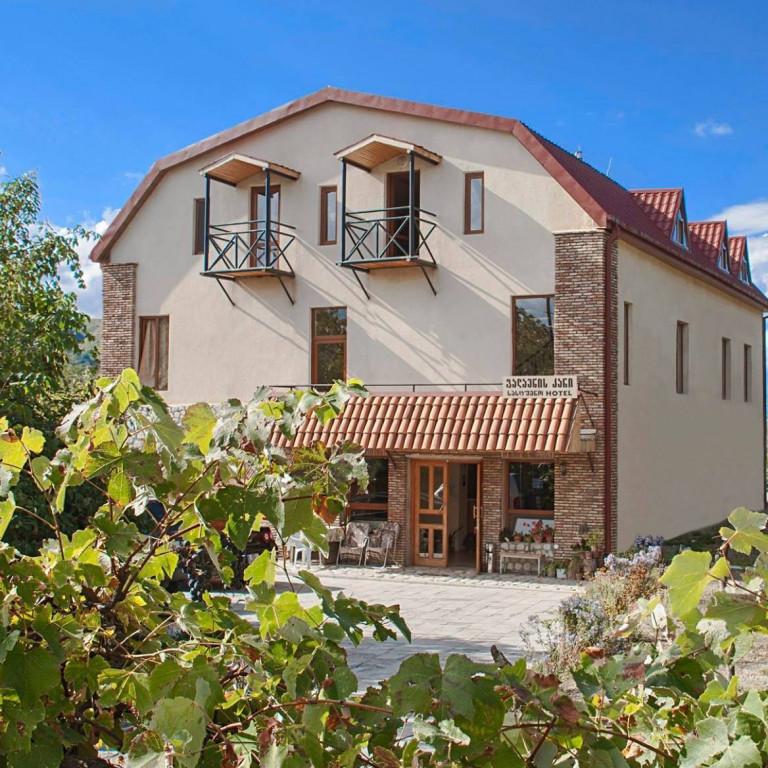
Help other travelers use your experience.
Review this destination, share your thoughts, impressions, pros and cons.
Let's make traveling easier than ever.
Davit Gareja (David Gareji Monastery Complex) - one of the most notable religious and cultural centers of Georgia, the monastery cave complex. It is located in Kakheti, Sagarejo municipality, 60-70 km south-east of Tbilisi, on Gareji hill.
The complex was founded in the first half of the VI century by one of the Assyrian fathers called David. He came and settled in a small, natural cave in the Gareji Desert with his disciple Lukyan. That is how the monastery was founded, it was known in the later centuries by name David lavra.
David Gareji Lavra was the center of monastery life. By the time it broadens and adds branches. Academician G. Chubinashvili could not avoid the fact that there was mentioned 12 monasteries, but the available material allowed him to consider only seven monasteries, like other scientists, he also linked the "twelve" as a symbol in the Christian religion.
Platon Ioseliani, except David's Lavra, lists another eleven monasteries: Agdgomis Tsamebuli, Bertubani, Dodo's Rka, Ioane Nathlissemeli, Chichkhituri, Tetr-senakebi, Magazana or Mgvime, Colagori, Mokhatuli, Verangareja and Pirukugmarti.
In one of his poems Vakhtang VI mentiones David Lavra, Bertubani, Chichkhituri, Natlismtsmeli, Tsamebuli, Dodo.
According to the territorial division of the Early Feudal Age, the Gareji monasteries were in the southern border zone of the Kakheti region. Monasteries are located in the Gareji Mountains that are parallel to Mtkvari river and in the territory of the lower part of the Ivri Gorge.
Time by time has been formed cave-shaped monastery complexes network: Tsamebuli, Nathlissemeli, Chichkhituri, TeTrsenakebi, Dodo’s Rka, Udabno, Agdgomis Tsamebuli, Bertubani, Mgvime, Kolagiri, Didi kvabebi, Verangareja, Pirukugmarti, Patara kvebi.
The activities of Davit Gareji Monasteries were a notable and important factor in the religious and cultural life of Georgians. At the beginning of the XII century, David The Builder made the monasteries of Davit Gareji part of the royal property, this way he promoted their development. Monasteries were dismissed from state taxes. In 1265, The Mongolian army by the command of Berke-khan raided and destroyed the Davit Gareja and its surroundings.
In the first half of the XIV century, in the reign of George V the Brilliant, Davit Gareja became a strong political and economic center. Monastery people took part in the work of the Kingdom and management of the church affairs of the country. At the end of the XIV century, the monastic life eliminated during the numerous trips of Tamerlane. In 1424, Alexander I the Great granted Davit Gareja to the Svetitskhoveli Patriarchate cathedral in Mtskheta. In 1616-1617 the Persian army attacked, the monasteries were abolished. In 1639, Teimuraz I restored the monastic life. David Gareja consisted of settlements and villages, where the peasants considered as a monastic servant. The Davit Gareji monasteries existed until the end of the XIX century.
Davit Gareji monastery building process has reached the zenith in XII-XIII centuries, during the cultural and political rise of Georgia. In Davit Gareji was developed monastic life and building style and was created own school of fresco painting.
The image of Davit Gareji monasteries of this period differs significantly from the previous monasteries. In the main churches and refectory, instead of earlier simplicity appeared the interest in the majesty, grandiosity and free, wide places. The impression was further strengthened by the wall paintings of the main churches and general refectory.
David Garegi's painting gives particular importance the numerous images of the church-building donors, Portraits of Georgian Kings (Tamar of Georgia and his son Giorgi IV of Georgia - Bertubani Church, present - State Museum of Art, Tbilisi; Demetrius II the Self-Sacrificer - the painting of the Church of the Udabno Monastery).
The portrait of the church-building donors is much more than the depictions of religious characters that prove the independence of the Georgian master from the schemes legalized by Byzantine art. It is worth mentioning the paintings of Bertubani refectory, which leaves a solemn and glorious impression. In the main church of the Udabno features scenes from the life of David Garejeli, Udabno Monastery Church apses also interesting with its painting, which is distinguished by expressive faces and dynamism.
In the late feudal period, a separate monastery complex was interconnected with the checkpoints and signaling towers which survived to us as ruins. The last centuries (XVII, especially XVIII century) is interesting with caves decorated with a gypsum fretwork.
In different period of time in Davit Gareja monastery worked for public good, Onofre Garejeli (XII c.), Demetre I, Onofre Machutadze (XVII-XVIII centuries), Sulkhan-Saba Orbeliani, Besarion Baratashvili-Orbelishvili, Nikoloz Cherkezishvili (XVIII), Gabriel Saginashvili (XVIII) Grigol Dodorkelli, Anton I, Timote Gabashvili, Gabriel Mtsire and others. They wrote manuscripts, composed collections, and helped other cultural centers. The rich found of manuscripts was protected in Davit Gareji.

Help other travelers use your experience.
Review this destination, share your thoughts, impressions, pros and cons.
Let's make traveling easier than ever.
Please login to ask a question
Ask a QuestionHi how can İ book a trip with u?
İ would like to go to David Gareja and to the rainbow mountains..
როდის დაარსდა დავითგარეჯა
გამარჯობა. ტურისტებისთვის დავით გარეჯის მონასტერი ღიაა?
გამარჯობა, როგორც ვიცით დავით გარეჯის მონასტერი ღიაა.